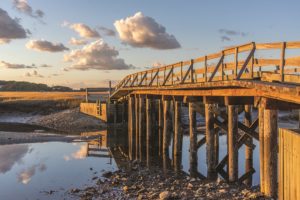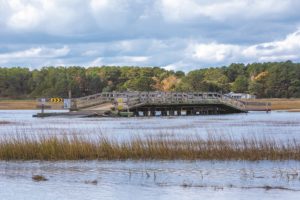WELLFLEET — William Huss, the president of the Lieutenant Island Association, got an urgent call from DPW Director Jay Norton on Oct. 29. Coastal Engineering, the contractor making long-planned repairs on the bridge to the island, had found rot in its support beams.
The town quickly imposed a 10,000-pound weight limit on vehicles crossing the one-lane wooden bridge that arches over the salt marsh and connects Lieutenant Island to the rest of the Cape — creating one more complication for those who live there.
Island residents have to keep close tabs on nature’s rhythms. Twice a day, high tide floods the Lt. Island Road causeway — the road that leads to the bridge — in salt water, which can reach waist-high and ruin a car for good. Those who don’t take the tide seriously, says Steve Wood, a year-round resident, risk being marooned.
Patty Madigan, another resident, says, “We don’t tell time. We tell tides.”
Although the DPW allowed an exception to the five-ton limit for fire trucks and ambulances in case of emergency, the ban temporarily prevented propane and oil trucks from crossing. FedEx and Amazon deliveries were also halted, as were trash services.
An interim fix to stabilize the structure was completed during the week of Nov. 8, and the emergency limit has now been lifted.

The planned bridge repairs originally began in May and were expected to be completed by Dec. 31. They were halted for the summer and started up again on Oct. 12. Then, on Oct. 29, the rot was found, despite regular inspections by both the state and town.
“It could not have been detected from a visual inspection,” Norton says. The contractor was replacing the decking, railing system, and abutments when it uncovered the problem. “Now we have to replace the stringers on both sides of the bridge.”
The town maintains Lt. Island Road, which elbows off Route 6 and twists into the salt marsh, running over the bridge and down the paved causeway. About a quarter mile into the wooded island it becomes D Street, where the private roads begin. “And we take it from there,” says Huss of the island’s home owners’ association.
The bridge repairs are thus under the purview of the DPW. The original restoration project was intended to bring the bridge up to national and state standards, according to the project’s bid documents, by replacing worn and deteriorated components. Those repairs will now occur in late winter or early spring of 2022, Norton says.
An Excuse to Flake
For part-time island resident Dan Okrent, the tides come with the “all-purpose excuse” to escape from social events. “You can say, ‘I’m sorry, we have to leave because of the tide,’ ” he says.
When Huss scans the tide chart, he says, anything less than 9.5 feet is good for a bridge crossing. His personal rule: a 10.5-foot tide means no access an hour before and after. “If it’s a 12-footer,” he says, “then you really need up to two hours on either side.”
Even residents can bungle the timing. One morning at 6:30, Carol Penfield, a nurse practitioner, realized she’d awakened too late. The high tide would block the causeway from 7 to 9 a.m. Her first patient was scheduled at 8 a.m. — in Yarmouth. Her mother came to the rescue, waiting in her car on the mainland side while Penfield pulled a pair of waders over her business attire and splashed through water, spare shoes held high. Her mother shuttled her to work and back.
Ed Bokhour, who moved to the island in 2019, once raced home from dinner only to find that several inches of water had already flooded the causeway. He plowed through, slowly. Once in his driveway, he made a beeline for the hose and washed the underside of his car “lest the salt attack it,” he says.
Pamela Zuckerman, another resident, once encountered two stalled cars mired in the marsh. “Hapless tourists had driven their cars through the salty tide,” she says. “And that was that.” It’s not unusual for islanders to see cars parked on the bridge for hours, waiting for the tide to go out.
Some choose to strap on a backpack and hoof it across. How much the tide has swelled governs which garments must go. Sometimes, going barefoot will suffice; other times, islanders shed their pants. The better prepared stow weathered sneakers in the trunk — or as Penfield did, a pair of waders.

Mark Wasserman has accepted encounters with high water as part of the “island experience.” At night, he finds it “comfortably creepy to slog through the darkness. Occasionally, a crab will scuttle over your toes or a fish would knock into your ankles.”
His neighbor Cheryl Walsh agrees. She says she’s always had fun “swimming in the road. ”
But the salt marsh critters spooked her daughter, who dreaded wading through the tide. She eventually found a use for her fears applying to college. The terrors of “walking through the ocean in the dead of night,” Walsh says, made for solid essay material.
Logistical Hassles
When the bridge repairs started, vehicles had to cross the bridge before construction began in the morning. When crews started work, the bridge was closed until late morning, when it would reopen for 30 minutes. This gave the workers a lunch break and residents a brief window for vehicle access.
“The half hour break,” Huss points out, “is not enough to get to the post office or the grocery store.”
Construction wrapped up in the afternoon, usually between 1 and 5. Islanders’ frustrations mounted because access times varied from day to day. The DPW advised residents to stock up on groceries and medicine.
That timeline has since been rescinded. There is no schedule until lumber arrives for the permanent repair, which is expected to take 8 to 12 weeks. “Outreach will occur prior to that,” says Norton, “and new schedules will be developed.”
Most Lt. Islanders live there seasonally, so they can go elsewhere during bridge construction. But it’s another story for year-rounders like Lydia Kotak, who retired and moved to the island permanently in 2018.
Kotak worries about the logistics of aging there. With the shifting tides, she and her partner have struggled to keep appointments. Bridge work further confounds things. The repairs originally scheduled for Oct. 25 to Nov. 12 drove the Kotaks to cancel appointments altogether — despite booking them two weeks out.
When the Oct. 27 storm hit, Kotak decided they would stay in a hotel. “There’s not much to count on if there’s a storm or something astronomical,” she says. As the winter approaches, neighbors have been departing for other homes, which makes emergencies more worrisome.
In 2016, a Lt. Island home caught fire. The Wellfleet Fire Dept., along with crews from Eastham, responded. The day was blustery, fanning the fire toward neighboring structures. The residents of the house were away, but their three dogs perished. Another fire took place on the island in March 2019. This time, the home burned to the ground. After the fire was extinguished, firefighters found the bodies of Cathleen and Ferdinand Kral.
Days Propane of Provincetown services about 20 homes on Lt. Island. In late October, before the repairs began, the company hurried to make deliveries originally planned for November. Currently, if anyone runs out of fuel, “we have the ability to bring them a temporary, smaller tank,” says Will Treese, the Days office manager.
UPS and FedEx carriers have been accommodating, according to Penfield. “On occasion, we have met them out on the mainland if they contact us,” she says.
Island resident Matt Egan has confidence that his neighbors will manage. “It’s a hardy crew out there,” Egan says. “We’ll survive.”
“It’s like nature’s slapping me in the face, saying, ‘You’re not the boss of me.’ I like it,” says Steve Wood. “I think it’s very romantic.”



